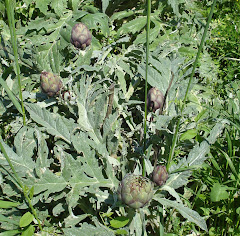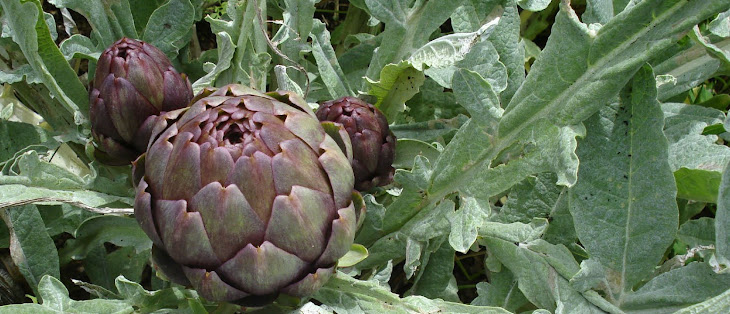The olive tree, Olea europaea, has become an essential symbol of the Mediterranean. When we planted a small one in our garden we attracted approving comments from our neighbours who said we should have one because 'Nous sommes dans le Midi' - we're in the Midi.
The olive tree is considered an indicator of the Mediterranean area which, the French historian Fernand Braudel said, begins with the first olive tree at the northernmost point and ends with the first palm grove in the south. It thrives only where there is a Mediterranean climate, but it is probably not indigenous and originated in Anatolia or further east in Iran.
Small bushy wild olive trees, Olea europaea oleaster, olivettes in French, still grow in the garrique all around the Mediterreanean. It is not known exactly when or where cultivation began, but it seems likely that it was in Crete during the Minoan civilisation around 3500 BC. Olive cultivation spread around the Mediterranean, to North Africa, where olives have been found in Egyptian tombs dating from 2000 BC, and to the western Mediterranean, brought by the Romans.
The oil was used for lighting and cooking, in religious rituals and as a remedy for illness. Excavations of Mycenaean sites in Greece have found evidence that herbs such as fennel, mint, sage and juniper were added to olive oil for medicinal use.
The olive tree has a significance beyond its agricultural value in cultures all around the Mediterranean. It is mentioned in the Koran and the Bible. In Greek mythology it was responsible for the naming of the city of Athens, when the goddess Athena won a contest for the most useful invention. Zeus judged her olive tree to be more useful to humanity than Poseidon's war horse and she planted the tree on the Acropolis. Someone who damaged or destroyed an olive tree in ancient Greece could be punished by death or exile. An olive branch is still seen as a symbol of peace.
The fact that the importance of this tree has a deeper meaning in Mediterranean culture than its value as a source of oil for food and light may be due to its almost mythical longevity and powers of regeneration. There are trees which are known to date back several millennia. Olive trees can survive being transplanted even at a great age. A few years ago a 1,000-year-old tree was moved from the Castellon region of Spain to a park in Royan in western France, leading to concern that Spain was selling its heritage and demands for ancient trees to be preserved in the same way as historic buildings.
Another olive tree which was moved to France from Spain is the 1,000-year-old one at the Pont du Gard in southern France which I photographed in 1994 almost exactly 100 years after it was brought here at the end of the nineteenth century. Its trunk is a good example of the beauty of these old trees.
When an olive tree is cut down or dies, within a short time new shoots grow up from the roots. Sometimes this renaissance seems almost miraculous. A couple of summers ago there was a fire in a new plantation of saplings beside the road between Roujan and Pézenas and many of the young trees were completely destroyed. Driving past the other day, I noticed that there is new growth around these dead trees. It's easy to see how the olive tree became a symbol of peace and life in ancient cultures and remains so today.














6 comments:
Lovely history. Thanks so much for writing this. I look forward to future installments.
Thanks for the lesson. Wish I could grow them here in Ohio. Maybe in a greenhouse. Looking forward to the next installment.
We were shown around a preserved olive press while we were on the island of Paxos in Greece. It was fascinating to see the initial donkey driven stones that ground up the olives and the next stage of squeezing out the oil. This was done by 2 or 3 men pushing a huge wooden leaver and then finally knocking it the last few inches using their hips. Ouch! Apparently you could recognise the workers by their limps. No longer done like that now of course.
Thank you all for your comments. easygardener: I'd love to have seen that olive press on Paxos, but it sounds like hard work!
Thanks for the wonderful post. I love the history. :)
very good post chaiselongue
easygardener describes the traditional olive press, you can't find many of these now in Greece
Post a Comment